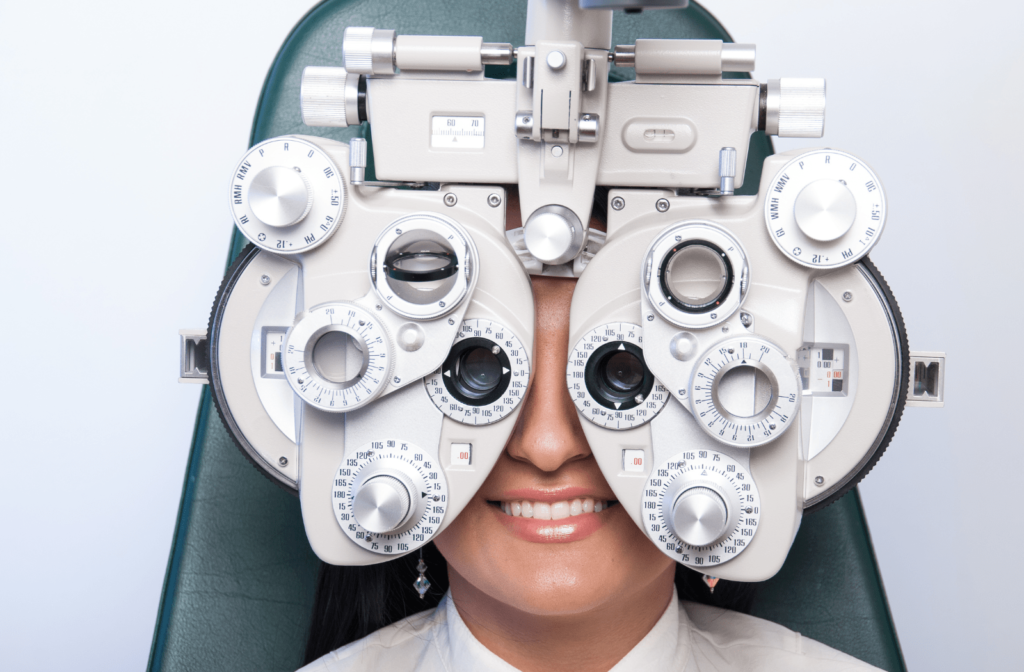Your eye health and vision should be your eye doctor’s primary concern. Fortunately, diagnostic equipment allows the optometrist to check for anything that could affect your vision, including refractive errors like astigmatism.
To check for astigmatism, your eye doctor typically uses a measurement tool called a phoropter to determine the shape and severity of the refractive error. With this information, they can recommend the best way to correct it.
Usually, this happens during a comprehensive eye exam. That’s another significant reason that getting regular eye exams is an essential part of taking care of your eyes.
Refractive Errors
Refractive errors are one of several common eye conditions that cause blurry or poor vision. It’s important to note that the existence of a refractive error doesn’t guarantee any problems with your vision. For example, you may actually have 20/20 vision yet have blurry vision up close due to uncorrected astigmatism.
Additionally, if a refractive error is left uncorrected, it could lead to complications like headaches or eye strain, even if the refractive error isn’t causing noticeable vision problems.
What Is Astigmatism?
You’ve probably heard of several refractive errors before—nearsightedness (myopia) or farsightedness (hyperopia), but let’s take a closer look at astigmatism today.
Astigmatism is a refractive error caused by an abnormal shape of the cornea or lens of the eye. They can happen at any age, and they can change over time as well. Like other refractive errors, an eye examination is the only way to diagnose it. Researchers have yet to discover the cause or find a way to prevent astigmatism.
How Astigmatism Is Measured
As mentioned above, one of the most common tools for measuring refractive errors like astigmatism. The measurements that doctors use are called diopters. A perfect eye would have 0 diopters when measuring for astigmatism.
Depending on the size of the astigmatism, the measurement may read higher. Between +0.5 and +0.75, diopters are standard in people with astigmatism. But +1.5 diopters is usually when the eye doctor recommends correction, like contact lenses or glasses.
Reading a Prescription
If you have questions about your prescription after your exam, your eye doctor can explain everything. Depending on what the optometrist is correcting, there could be a few different numbers or labels.
Two other measurements that are specific to astigmatism are:
- Cylinder: Picture a normal-shaped eyeball as a basketball shape. The cylinder measurement is how severe the astigmatism is. The higher the measurement, the more your eye is shaped like a football instead of a basketball.
- Axis: Astigmatism doesn’t necessarily affect the entire cornea or lens. The axis is the measurement of where on the eye the refractive error is.
These are a few measurements that the eye doctor considers when making prescription lenses or ordering contact lenses.
Common Correction Options for Astigmatism
If the eye doctor determines that the astigmatism is severe enough to need correction, they may recommend a few common options. They will discuss your vision needs or overall eye health before recommending the best options.
Prescription Glasses
For many people, a pair of prescription glasses is the simplest way to get clear vision. Many eye doctors have multiple lens options for people with complex vision needs. Plus, some really stylish frame designs nowadays match anyone’s style.
Contact Lenses
Contact lenses may be the better option if someone spends a lot of time playing sports or wearing safety eyewear for work. Even if a person is dealing with more than astigmatism, specialty lenses may still be an option.
For example, dry eye disease often makes someone an unsuitable candidate for contact lenses. But some specialty lenses, like scleral lenses, may make it possible.
Refractive Surgery
A more permanent solution is preferable to some people, so refractive surgery is another relatively common corrective action. There are several refractive laser eye surgeries available that you can discuss with your eye doctor.
They can review all the pros and cons of each procedure with you to determine which might be the best option.
Book Your Next Comprehensive Eye Exam
Even if you’ve had good vision your whole life, it’s possible to develop astigmatism at any time. But if your eye doctor detects one in your eye during an exam, that doesn’t automatically mean you’ll need glasses. However, your optometrist can make that recommendation based on the severity of the refractive error and your vision needs.
If you’re ready for your next exam in Spokane or Chewelah, contact us today. Let our dedicated and professional team answer your questions and get you in to see the eye doctor. We care about your vision as much as you do.



